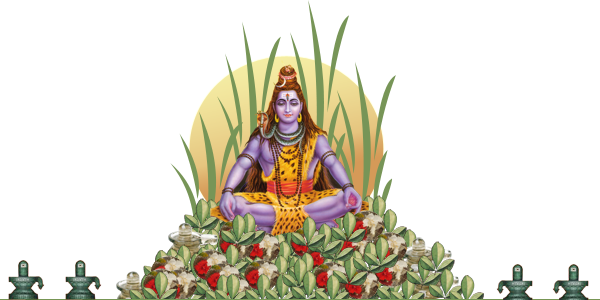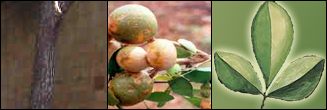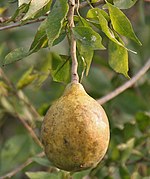A plant that is very sacred to Lord Siva .
You can buy and donate to temples or you can plant in your home too.
Every temple and every home should have this plant.
It will be a wonderful karma yoga. RM90 per plant.
Some information about Vilvam.
Bael (Aegle marmelos) (also known as Bengal quince, stone apple), Bilva or வில்வம் (Tamil) is a species of tree native to India. It is present throughout Southeast Asia as a naturalized species.[1] The tree is considered to be sacred by Hindus. Its fruits are used in traditional medicine and as a food throughout its range.
Botanical information
Bael is the only member of the monotypic genus Aegle.[1] It is a mid-sized, slender, aromatic, armed, gum-bearing tree growing up to 18 meters tall.
Bael occurs in dry forests on hills and plains of northern, central and southern India, southern Nepal, Sri Lanka, Myanmar, Pakistan,Bangladesh, Vietnam, Laos, Cambodia and Thailand. It is cultivated throughout India, as well as in Sri Lanka, the northern Malay Peninsula,Java, the Philippines, and Fiji. It has a reputation in India for being able to grow in places that other trees cannot. It copes with a wide range of soil conditions (pH range 5-10), is tolerant of waterlogging and has an unusually wide temperature tolerance (from -7°C to 48°C).
- The Lime Butterfly: Papilio demoleus
- The Common Mormon: Papilio polytes
[edit]Fruit
The bael fruit has a smooth, woody shell with a green, gray, or yellow peel. It takes about 11 months to ripen on the tree and can reach the size of a large grapefruit or pomelo, and some are even larger. The shell is so hard it must be cracked with a hammer or machete. The fibrous yellow pulp is very aromatic. It has been described as tasting of marmalade and smelling of roses. Numerous hairy seeds are encapsulated in a slimy mucilage.
[edit]Uses
The fruit is eaten fresh or dried. If fresh, the juice is strained and sweetened to make a drink similar to lemonade. It can be made into sharbat (Hindi) or bel pana (Bengali: বেল পানা) or Bela pana (Oriya: ବେଲ ପଣା), a refreshing drink made of the pulp with water, sugar, and lime juice, mixed, left to stand a few hours, strained, and put on ice. One large bael fruit may yield five or six liters of sharbat.
If the fruit is to be dried, it is usually sliced and sun-dried. The hard leathery slices are then simmered in water.
The Tamil Siddhars call the plant koovilam (கூவிளம்) and use the fragrant leaves for medicinal purposes, including dyspepsia and sinusitis. A confectioncalled ilakam (இளகம்) is made of the fruit and used to treat tuberculosis and loss of appetite.[2] It is used in Ayurveda for many purposes, especially chronic constipation.
[edit]Use in religious rituals
The fruit is also used in religious rituals. In Hinduism the tree is sacred. It is used in the worship of Shiva, who is said to favor the leaves. The trifoliate leaves symbolize the trident that Shiva holds in his right hand. The fruits were used in place of coconuts before large-scale rail transportation was available. The fruit is said to resemble a skull with a white, bone-like outer shell and a soft inner part, and is sometimes called seer phael (head-fruit). However, it is quite likely that, the term 'Seer Phal' has coined from the Sanskrit term 'ShreePhal, which again is a common name for this fruit. Many Hindus have bael trees in their courtyards.
In the traditional culture of Nepal, the bael tree is part of a fertility ritual for girls known as the Bel baha. Girls are "married" to the bael fruit and as long as the fruit is kept safe and never cracks the girl can never become widowed, even if her human husband dies. This was seen to be protection against the social disdain suffered by widows.

Maha Shivaratri is considered the most auspicious time to please Lord Shiva to gain his blessings. What is the simplest way of appeasing Lord Shiva? Offer him Bilva leaves.
 The most terrible karma is destroyed when a Bilva leaf is offered to Lord Shiva. The unbelievable merits one receives on offering a single Bilva leaf to Lord Shiva are described in the 9 verses of the sacred hymn known as Bilvashtakam. The most terrible karma is destroyed when a Bilva leaf is offered to Lord Shiva. The unbelievable merits one receives on offering a single Bilva leaf to Lord Shiva are described in the 9 verses of the sacred hymn known as Bilvashtakam.Glory of the Bilva Tree
Scientific Name – Aegle Mermelos
English Name – Golden Apple/ Stone Apple
Just like Tulsi plant is sacred to Lord Krishna and Durva grass is sacred to Lord Ganesha, Bilva tree is sacred to Lord Shiva. Since the Bilva leaf has such significance in the worship of Lord Shiva, it is common to find Bilva trees cultivated in the vicinity of Shiva temples.
|
According to Shiva Purana, the great epic on Lord Shiva, the Bilva tree is the manifest form of Lord Shiva himself, while all the great tirthas (pilgrimage places) are said to reside at its base. One who worships the Shiva Linga while sitting under the Bilva tree attains the highest bliss of oneness with Lord Shiva.
For Happiness and Prosperity – Perform Bilva Pooja with flowers and incense For Supreme Knowledge – Light deepa (lamp) before Bilva tree For Freedom from Vice – Remove new leaves from one of the branches of Bilva tree and worship the tree with them For Growth of Virtue – Feed a Shiva devotee under the Bilva Medicinal Properties of Bilva Tree
Ayurveda (science of health) values the Bilva highly for the medicinal properties contained in its root, fruit and leaves. These are used in various Ayurvedic preparations.

Root – A preparation made from the root with ginger and toasted rice cures vomiting. For the treatment of piles, dysentery and diarrhoea, a preparation is made from the root mixed with another tuberous root. The oil extracted from the Bilva root, boiled with the juice of Bilva leaves and applied to the head is excellent for nasal catarrh and diseases of the ear.
Fruit – Its pale tawny flesh is sweet and astringent, containing tannin, which acts as an astringent to the bowels. It has a pleasant, agreeable and aromatic flavor, and provides an excellent dietary supplement. The pulp of the dried Bilva fruit, powdered and mixed with arrowroot, is called ‘dietetic Bel’. It is both a sustaining food and a curative medicine.
Leaves – The consumption of Bilva leaves alleviates diseases caused by excess vata and kapha (mucus). They are also useful in diabetes mellitus. For this, a few leaves should be chewed daily and their fresh juice drunk. They are diaphoretic (producing more perspiration), thus reducing temperature and lowering fevers, and an aphrodisiac. A decoction of leaves is a favorite remedy for ailments that often occur during seasonal changes, such as fever, flu and fatigue.
Plant a Bilva Tree this Maha Shivaratri
May the next tree you plant be a Bilva Tree! It will not only show your commitment towards greening the environment, but also display your concern for humanity, given such divine merits and medicinal value of the Bilva Tree.
A bilva sapling must be tenderly nurtured and protected until it has reached a certain height right for transplanting. Quite like a fragile baby bird that must be carefully tended until such time it leaves the nest to flourish independently.
AstroVed will arrange to have your sponsored sapling cared for at Tripura Foundation’s charity project ‘HoPE Town’ in the agricultural vocational until until such time in it’s development where it will be donated to a Shiva Temple. It’s leaves will then be used in temple rituals and festivals.
Your sponsorship of a sapling will benefit those who are served in the charity program by giving work, benefit the temple by providing not only the leaves but for the energy that the tree will bring to the surroundings as a place in itself for worship and the mature tree will provide a source of traditional herbal medicine. You’ll be benefited by having the grace of Lord Shiva showered upon you for this act.
Shiva Bilva Ashtakam Stotra Meaning
Tridalam Trigunakaaram Trinethram Cha Triyayusham,
Trijanma Papa Samharam Eka Bilwam Shivarpanam 1
I offer one leaf of Bilwa to Lord Shiva,
Which has three leaves, Which causes three qualities, Which are like the three eyes of Shiva, Which is like the triad of weapons, And which destroys sins of three births.
Trishakhai Bilwapathraischa Hyachidrai Komalai Shubai,
Shiva Poojam Karishyami, Eka Bilwam Shivarpanam 2
I offer one leaf of Bilwa to Lord Shiva,
Which has three shoots, Which do not have holes, Which are good and pretty, And worship Lord Shiva.
Aganda Bilwa Pathrena Poojithe Nandikeshware,
Shudhyanthi Sarva Papebhyo, Eka Bilwam Shivarpanam 3
I offer one leaf of Bilwa to Lord Shiva, For if an uncut leaf is offered,
To his steed the god Nandi, We get cleaned of all our sins.
Salagrama Shilamekaam Vipranam Jatha Cha Arpayeth,
Soma Yagna Maha Punyam, Eka Bilwam Shivarpanam 4
I offer one leaf of Bilwa to Lord Shiva,
For it is equal to, offering a saligrama to a Brahmin, Or the great blessing got out of performing Soma Yaga,
Dandi Koti Sahasrani Vajapeya Sathani Cha,
Koti Kanya Maha Danam, Eka Bilwam Shivarpanam 5
I offer one leaf of Bilwa to Lord Shiva,
For it is equal to gifting thousand elephants, Or the performing of hundred fire sacrifices, Or giving away billions of girls.
Lakshmyasthanutha Uthpannam Mahadevasya Cha Priyam,
Bilwa Vruksham Prayachami, Eka Bilwam Shivarpanam 6
I offer one leaf of Bilwa to Lord Shiva,
For it is equal to giving a tree of Bilwa, Which was born from the breast of Lakshmi, And which is very dear to the Lord Shiva.
Darshanam Bilwa Vrukshasya, Sparsanam Papa Nasanam,
Aghora Papa Samharam, Eka Bilwam Shivarpanam 7
I offer one leaf of Bilwa to Lord Shiva,
As seeing and touching of a tree of Bilwa, Washes away ones sins and also very great sins.
Kasi Kshethra Nivasam Cha Kala Bhairava Darshanam,
Prayaga Madhavam Drushtwa, Eka Bilwam Shivarpanam 8
I offer one leaf of Bilwa to Lord Shiva,
After living in the city of Kasi, Seeing the Kala Bhairawa, And also visiting the temple Of Madhawa in Allahabad.
Moolatho Brahma Roopaya, Madhyatho Vishnu Roopine
Agratha Shiva Roopaya, Eka Bilwam Shivarpanam 9
I offer one leaf of Bilwa to Lord Shiva, As Brahma resides at its bottom,
Lord Vishnu lives in its middle, And Lord Shiva lives in its tip.
Bilwashtakam Idham Punyaam, Padeth Shiva Sannidhou,
Sarva Papa Nirmuktha Shiva Loka Maapnuyath 10
Reading this holy octet of Bilwa, In the presence of Lord Shiva,
Would save one from all sins, And in the end take him to the world of Shiva
Bless and Love.
Om Namasivaya
Sivajnani Nagappan
Artha Dharma Concept Builders
Contact : +6012 9259495
Email : artha.dharma@gmail.com |




No comments:
Post a Comment